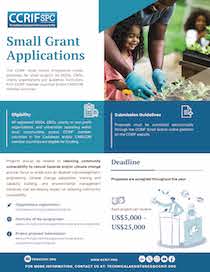Grand Cayman, Cayman Islands, June 5, 2012 – As the 2012 Atlantic Hurricane Season begins, all sixteen member governments of the Caribbean Catastrophe Risk Insurance Facility (CCRIF) have committed to renew their hurricane and earthquake insurance for the 2012-2013 policy year. Since CCRIF’s inception in 2007, these countries have incorporated catastrophe insurance into their national disaster risk management programmes by purchasing CCRIF’s parametric hurricane and earthquake coverage.
The US National Oceanic and Atmospheric Administration (NOAA) forecasts that the 2012 Atlantic Hurricane Season will have slightly reduced activity compared with the 1981-2010 average. NOAA’s Climate Prediction Center estimates that 2012 will have nine to fifteen named storms, including four to eight hurricanes, one to three of which will become major hurricanes (with peak winds of 111 mph or higher, ranking Category 3, 4 or 5). Caribbean countries have long recognised the need to prepare for the annual hurricane season. Notwithstanding the economic downturn facing many Caribbean countries, there is a realisation of the importance of allocating resources for disaster risk reduction and risk transfer initiatives within a comprehensive disaster risk management framework.
For the 2012-2013 policy year, which began on June 1, CCRIF provided its member countries with a premium rebate equal to 25% of the premium paid in the previous policy year. This came on the heels of a quiet 2011-2012 policy year in which none of the policies held by member countries were triggered. Mr. Isaac Anthony, Permanent Secretary in Saint Lucia’s Ministry of Finance, Economic Affairs and National Development and CCRIF Board Member, says that “this initiative provides a tangible benefit to CCRIF’s members if payouts during the prior year result in a significant underwriting profit, while fully maintaining CCRIF’s sound financial position and its unparalleled ability to pay the claims of its members.”
CCRIF has encouraged member governments to use these savings either to purchase additional coverage or to implement programmes for improving hazard risk resilience as well as climate change adaptation towards reducing the impact of natural hazards. Speaking at a recent forum on Globalisation, Climate Change and Rural Resilience at the University of the West Indies, World Bank Sector Manager, Sustainable Development for China and Mongolia, East Asia and Pacific, Ede Ijjasz-Vasquez stressed that “countries that are ready for the disasters and challenges of today would be in a much better position to handle climate change, in whatever direction it takes us.”
It is important to note that this year CCRIF will add the excess rainfall product to its portfolio of offerings to Caribbean governments. This product covers extreme rainfall events, which are not included in current hurricane policies. CCRIF’s hurricane policies are based on wind and storm surge.
Since 2007, the Facility has made eight payouts – on three earthquake policies and five hurricane policies – totalling US$32,179,470 to seven member governments. All payouts were transferred to the respective governments less than a month (and in some cases within a week) after each event. CCRIF funds have often been the first infusion of cash to arrive in these countries after the event and have been used to capitalise special recovery funds, to restore services and clear affected areas and generally to “keep the wheels of government turning” immediately following a disaster.
About CCRIF: CCRIF is a not-for-profit risk pooling facility, owned, operated and registered in the Caribbean for Caribbean governments. It is designed to limit the financial impact of catastrophic hurricanes and earthquakes to Caribbean governments by quickly providing short-term liquidity when a policy is triggered. It is the world’s first and, to date, only regional fund utilising parametric insurance, giving Caribbean governments the unique opportunity to purchase earthquake and hurricane catastrophe coverage with lowest-possible pricing. CCRIF represents a paradigm shift in the way governments treat risk, with Caribbean governments leading the way in pre-disaster planning. CCRIF was developed through funding from the Japanese Government, and was capitalised through contributions to a multi-donor Trust Fund by the Government of Canada, the European Union, the World Bank, the governments of the UK and France, the Caribbean Development Bank and the governments of Ireland and Bermuda, as well as through membership fees paid by participating governments.
For more information, please send an email to pr@ccrif.org.
English





